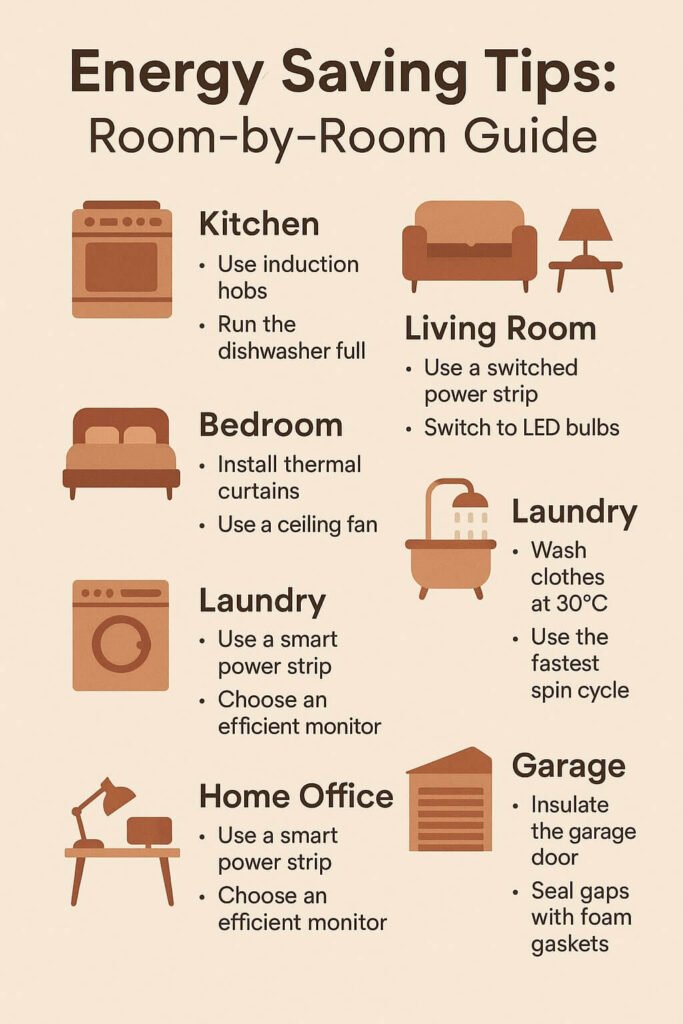If you’ve ever stood next to a draughty window in February or looked at your energy bill wondering if your toaster secretly runs a nightclub at night, you’re not alone. Most of us know there’s waste lurking behind our walls, under the floorboards, or humming quietly behind the TV—but where do you start? This is the room-by-room guide I wish I had five years ago when we first moved into our 1950s semi, armed with ambition, thick socks, and a slightly suspicious boiler.
We’re not talking high-cost solar panels or gut renovations here. These energy saving tips are practical, proven, and just plain smart. A mix of tech tweaks and old-fashioned common sense, designed to help your home run smoother—whether you’re in a one-bed flat or a four-bedroom fixer-upper.

Kitchen: Cut the Waste, Not the Warmth
Start where your appliances never sleep. Ovens, fridges, kettles—they’re the heartbeat of any home but can eat more power than they should.
- Induction hobs use up to 50% less energy than gas because they heat the pan, not the air around it.
- Only boil the water you need—especially if, like me, you’re on cup of tea number five by lunchtime.
- Dishwashers run best fully loaded. One less cycle a week saves money and water.
- Retire that ancient second fridge in the garage. It might be costing you £100+ a year to cool last year’s chutneys.
Living Room: Where Lazy Watts Hide
This is where your ‘phantom load’ lives—those sneaky devices sipping power even when off.
- Plug your TV, game consoles, and soundbars into a switched power strip and turn it off before bed.
- Swap halogen bulbs for LEDs. You’ll get the same warm light for a fraction of the cost.
- Pull the blinds during summer days. It’s a simple trick to keep heat out and save on cooling.
If you’ve never checked your TV’s energy label, now’s the time. ENERGY STAR-rated models run cooler and cheaper without skimping on your Saturday film marathon.
Bedrooms: Keep Cosy, Sleep Smart
Even a small tweak makes a difference where you snooze.
- Thermal curtains or cellular blinds trap heat in winter and block it out in summer.
- Install a ceiling fan and reverse its direction with the seasons—it’ll push warm air down in winter and lift it in summer.
- Keep chargers off overnight. A switched-off socket is your cheapest insulation.
Bathroom: Hot Water, Cold Facts
Between the steamy showers and quick shaves, your bathroom is a quiet power sink.
- Fit a low-flow showerhead (aim for WaterSense-certified models). It can save you thousands of litres a year.
- Shorter showers (4–5 minutes) don’t just save hot water—they save time.
- Use a heated towel rail with a timer, not all day long. Your towels don’t need a spa experience.
Laundry Room: Spin Smart
This one took me a while to learn.
- Wash at 30°C unless something’s truly mucky. It saves on heating energy.
- Always use the fastest spin cycle—you’ll cut drying time dramatically.
- Air-dry where you can. I hang clothes in the hallway on sunny winter days and haven’t looked back.
Home Office: Tech Without the Drain
The pandemic taught us how power-hungry working from home can be.
- Use a smart power strip that cuts power to your monitor or printer when the laptop goes to sleep.
- Choose an efficient monitor or laptop. ENERGY STAR models draw far less idle power.
- Natural light trumps fluorescents for your wallet and your mood.
Whole House: Clever Core Changes
Here’s where you can really future-proof.
- Invest in a smart thermostat. The better ones learn your schedule and adjust automatically.
- Stick to the 68/78 rule: 20°C in winter, 26°C in summer. Small shifts, big savings.
- Seal gaps around doors, windows, and skirting boards. You’d be amazed how much heat escapes unnoticed.
Even our dog appreciates a less draughty hallway.
Garage & Utility: Tidy Up the Cold
Garages are often left out, but they’re the gateway for chilly air and summer heat.
- Insulate the garage door or swap it for one with built-in panels.
- Use foam sill gaskets to block cold spots where walls meet floors.
A weekend job with a foam gun can transform a cold workshop into a year-round space.
Real Talk: What We’ve Noticed
Since making just half of these changes, our energy bill’s dropped by about 18% year-on-year. It didn’t happen overnight, and we still leave the hallway light on too often. But it feels good. It feels like control.
This isn’t about perfection—it’s about momentum. Pick one room, try two energy saving tips, and watch them ripple through the rest of the house. You’ll save money, lower your carbon footprint, and maybe even enjoy the smug glow of someone who’s figured out how to boil a single cuppa without powering the national grid.


